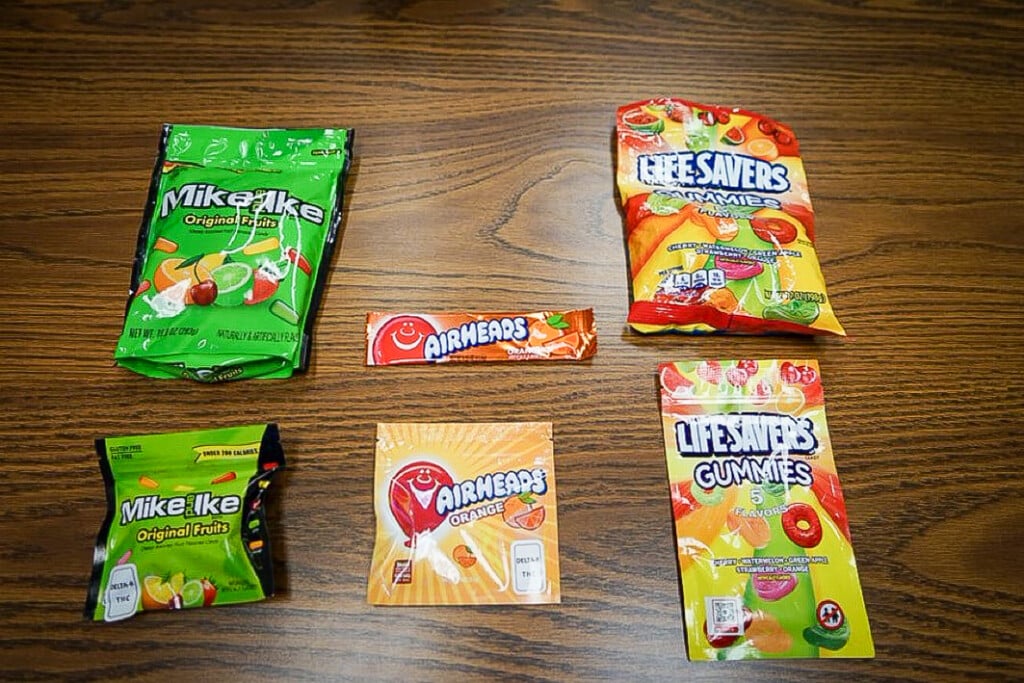The Underdogs of Southeast
His only goal as he fielded the kickoff was not getting leveled before his first step.
Reggie Johnson’s team, the Southeast High School Knights, had just given up another touchdown. The Grain Valley Eagles led, 27-0. And the second quarter had just started.
As Johnson caught the kickoff, he could already see blue Eagles uniforms pounding down the field toward him. He was a head shorter than most of the opposing team. The Southeast junior, with closely cut black hair, stands around 5 feet 6 inches tall.
Johnson broke to the left and ran. Three Eagles players converged on the same spot to meet him at the 30-yard line. He knew he was going down. Hit them hard, he thought. Don’t get any negative yards.
Johnson ducked his head so he could lead with his helmet. He propelled himself forward, his feet momentarily leaving the ground. He looked like a bullet on impact, and the group collapsed together. The return finished just shy of 20 yards.
Johnson left the field and pulled off his helmet. Brown dirt crumbled from his dull-red jersey. The Knights’ coach, Jay Lewman, patted him on the shoulder.
Ask any kid on the Knights why he plays, and you’ll almost always get the same answer: “I like to hit.”
“You get a chance to make contact with another guy, and you don’t get in trouble,” says Antoine Day, a 17-year-old senior, a team captain and sometime quarterback.
The good hits provided consolation during a rough season. The Knights began their year with a forfeit and three losses before chalking up a win over Westport High School in October.
The Knights are victims of school district restructuring and community apathy that have created inequities in sports programs. Inner-city schools such as Southeast that once boasted strong football teams and little else can now barely field enough players. Good football players can simply transfer to better schools.
Southeast lost many of its athletes when the Kansas City, Missouri, School District relocated the school’s students to the Manual Career & Tech Center on Truman Road. The charter school uses an African-centered education program for kindergarten through 12th grade. Many of Southeast’s football players transferred to more traditional schools.
The Knights went into games fighting for respect as much as to win. “Our chances are very slim,” Cleon Foreman, an 18-year-old senior and one of the team captains, said before the game. “I know that, player for player, we’re probably evenly matched with Grain Valley. But they got busloads of people, and we’re going to get tired.”
Looking at the two sides of the field, it was clear that Foreman was right. Southeast fielded 18 players for this game, requiring many of them to play both offense and defense without a break. Grain Valley had close to 60. There were so many blue jerseys lining the opposing sideline that, from the Southeast side, you couldn’t even see the Grain Valley cheerleaders, except when one was suddenly tossed in the air.
The difference in the crowd was startling. Grain Valley’s side of the stands was full of people who came to see the 8-0 team. Behind Foreman, there was a handful of cheerleaders who lacked pompoms. About 15 people sat on the Southeast side, most of them Grain Valley kids who thought it would be fun to sit in the opposition’s bleachers. Six were with the cheerleading program. For most of the game, there were no parents. “We’re fighting them,” Foreman said, studying the field. “We’re doing way better than I thought we would.”
While he talked, the Eagles scored another touchdown.
With nine days until the Grain Valley game, the Knights knelt before Lewman on a patch of worn ground behind the Manual Career & Tech Center. The spot is less than half the size of a normal football field, surrounded by a baseball-style backstop.
“How many of you know about the battle of Thermopolis,” Lewman asked them, “where 300 Spartans held off thousands of Persians?” The 61-year-old coach wore a biker-rally T-shirt. There was a bulge in one white gym sock where he kept a can of chewing tobacco, and every so often he spat, lips puckered between the bars of a Fu Manchu mustache.
A few players looked to one another for explanation. There were some confused mutters before someone said, “He’s talking about that movie 300.” A murmur of recognition prompted the coach to continue.
“Yeah, that’s right,” said Lewman, who works as a guidance counselor at Westport High School. “Well, that’s what you got to do. There’s not a man among you I wouldn’t go to war for. Some of you probably don’t believe that, but it’s true. Because if you’re finishing out this season, you’re showing me that you’re ready to be men.”
Lewman trying to rally his team with comparisons to the Spartan battle wasn’t a stretch, at least in terms of resources. There’s not even a goal post on Southeast’s field for the kickers to practice. There’s a fully stocked weight room in the school’s lower level, but players preparing to work out change clothes in a long, narrow storage area instead of a locker room.
When it was at 3500 East Meyer Boulevard, Southeast had a full-sized football field. But the school moved this year to combine with an elementary school and a middle school. The charter program utilizes African history and cultural lessons to target black students, who the program’s supporters believe have been ignored by traditional schools.
School district spokeswoman Cynthia Wheeler-Linden says Southeast’s sports teams got lost in the shuffle when the school moved. “The move was part of it, but I don’t know how much of it was just the move. Extracurriculars have lost their historic flavor,” she explains. “People used to fight to watch a team like Southeast and Lincoln College Prep play. Now we’re trying to rebuild the community support.”
District officials have been unable to address how the Knights became so impoverished so fast. The district’s assistant football director, Caleb Clifford, says he doesn’t know how funds have been allocated in the past. Ed Corporal, who started as the district athletics director this fall, says he hasn’t been in his job long enough to understand where every dollar is going.
In late October, The Pitch asked school district officials to provide budget information that would show how Southeast’s budget compared with those of other schools. On November 30, the district provided documents that broke down the overall $537,622 budget for athletic spending. But the documents did not include a school-by-school breakdown, and district officials said last week that such an itemization was not readily available.
Southeast has no booster club. Alumni occasionally return to talk to today’s players, but the team lacks any organized fundraising. With players transferring out of the school as the preseason practices got under way, it was uncertain whether the school would even have a football team. During preseason practices in August, the Knights had just 17 players. By the first game, against Northeast High School on September 7, two more had joined. But not enough players had completed the 14 practice days required by the state, and Southeast was forced to forfeit the season opener.
“We didn’t know we were going to have a football team until a week or so before the first game,” Lewman says. “With the move, that started the rumor mill about whether or not we’d even have a team, and we lost some players. But then some started coming in.”
At its peak this season, the Knights had roughly two dozen players, but by season’s end, there were just 18. Some were just sick of losing. “Nobody goes onto a field expecting to lose. They go out there to win,” Lewman says. “They got a lot of heart. After a while, though, it hurts.”
Lewman was born in Galena, Kansas, and he excelled at sports in school in the small town. His professional life has been an odd combination of teaching jobs and occasional construction work. He has a seemingly inexhaustible supply of PG-rated insults. When a lineman flubbed a play during practice one afternoon, he said, “You look like a three-legged dog trying to bury a turd in ice.”
He sees his primary charge as pushing the team to work together. At the practice before the Grain Valley game, Lewman faced his team while perched on the back of a sled mounted with four padded dummies. He told them to line up four at a time and jump into the pads as one. “Together! Together! Together!” Lewman yelled. In between stances, the team knelt like altar boys before the pads, ready to spring and repeat the drill.
Lewman hands out affectionately crude nicknames. One running back, 17-year-old Bryce Pulliam, earned the nickname Pissant because of his size. Pulliam is 5 feet 3 inches tall and weighs 110 pounds in full pads and helmet. Pulliam, a junior, missed last season because his grades were below the required C average. During his first game this year, Pulliam tackled an opposing player so hard that he gave himself a concussion. He played the rest of the game, and even made the last defensive tackle, before anyone realized he was hurt.
Another student, a bearded senior and four-year program veteran named Derek Suber, is “Boy Named Sue.” The soft-spoken athlete, quieter than his teammates, was one of the team’s leaders. “I play fullback, defensive end, kicker and punter,” Suber explained at practice one day as he watched the younger players to make sure they were paying attention to Lewman. “I just take them aside one by one and tell them how they should be doing and what they should be doing,” he said. “I know when they’re paying attention because, if they are paying attention when the coach is coaching, then they look at the coach. They don’t look at anybody else. If people pay attention, I don’t really say much to them.”
Antoine Day was preparing himself for NFL stardom. “I know college scouts are looking at me,” he said. “I’m a very aggressive player, very versatile.” Day started at quarterback, but with so few players, he often lined up as a receiver or a linebacker. With so few reserves on his side, Day knows that teams like Grain Valley can simply wear down the Knights.
“We always got a chance,” Day said. “I know I’ll get tired, but that’s not the time to think about it. I got to lead the team.”
Halfway through the second quarter, Day stood on the sidelines with his jersey and pads off. He had strained his arm somehow, either from throwing or getting pounded by Grain Valley linemen. One of the Knights yanked on Day’s arm, trying to get the muscles back in order. Reggie Johnson took his place at quarterback.
“They just been hitting it all night. I threw it and it went out,” Day said. “I don’t know what happened. Got a knot in here or something.”
Four minutes into the second quarter, Pulliam fumbled a kickoff return. Grain Valley took over at the 17-yard line and quickly scored again, making it 41-0. During the next kickoff, Pulliam made it 15 yards before an Eagles player spun him around by the jersey, lifting him off the ground as if to launch him, then dropped him. Lewman stalked the sidelines and talked to himself: “You think you have the game under control….”
The Grain Valley students sitting in the Southeast stands left in the second quarter, but Southeast now had one parent. Henry Pulliam, Bryce’s father, wore a blue Super Bowl XXV jersey and a gray tweed cap. He stood on the bleachers, watching the game over the cheerleaders’ heads. The Southeast cheerleaders still shouted and stomped, despite the score.
On the Grain Valley side, with victory a sure thing, talk in the stands was no longer on the game. Instead one couple talked about their recent trip to Disneyland. Another woman discussed her flight plans. “I just hate flying in those small planes. I feel so much safer in the big ones.” The cheerleaders jumped on a padded mat, a luxury not extended to the Knights’ girls.
At halftime, the Grain Valley band filed onto the field. The visiting locker rooms are in the high school’s main building, about a quarter-mile from the field. There was no sense using the 20-minute break to walk back and forth, so Lewman gathered the Knights near the north goal line. Day massaged his shoulder. The rest of the players lay on their backs beneath the goal post. A few listlessly tore at the grass.
Lewman stood before them. He lectured his players against trying to struggle forward after being hit. “Is this Dancing With the Stars?” he asked. “When you get tagged, go down!”
The coach looked for something positive. “We hit them hard for a quarter and a half, and they were shook. They weren’t ready for that. So I know you got it in you. Let’s get our pride back.”
As the team stretched out, Suber came up behind Lewman. “Coach, why don’t we do that rotation?” he suggested. “Moving the guys in and out of the line will keep us fresh.”
Lewman nodded. “Yeah, we could try that out.”
Day approached the coach next. He wanted to quarterback again.
“Let’s see you roll your arm,” Lewman said, and he swept his own arm around from back to front. Day mimicked the motion as best he could. Lewman shook his head. “If you can’t move it and you get hit on it again, that means you’re going to get hurt.”
“I can do it,” Day said. “Let me do some practice passes.”
Lewman shook his head. “I don’t want you to get hurt.”
Day walked away, muttering something under his breath.
Lewman shouted, “Hey! Did I say no?”
Two days before the Grain Valley game, Day sat at the ground level of the Manual Career & Tech Center, near the door to the weight room. Day grew up watching his brothers play football. He’d waited years for his turn.
“I have, oh, eight or nine of them,” he said. “One went to Emporia State to play college ball. Another played college, too. That’s what I want to do.”
At the start of the season, Day’s niece had just been born, and his sister and grandmother needed help. “I came in two weeks after they started. I just had to help at home, helping out my grandmother. When you got a 1-month-old baby at the house, you got a lot to take care of.”
As a senior, Day looks for players who haven’t been showing up for practice and tries to talk them into returning. “Just yesterday, a guy quit at practice because he hadn’t been showing up, and Lewman was going to make him run and he didn’t want to run,” he said. “He told me he’d be back, and I believe him. Deep down, I know he didn’t want to quit.”
The Knights complain that opposing teams expect them to be thugs because they’re at an inner-city school. During the October 5 game against Westport, Suber heard Westport fans say they expected a riot to break out.
“I just hear them talking about how, if we don’t win, we were going to fight the other team,” Suber said. “Everybody stereotypes — I understand that. But we’re not that way.”
Looking at Southeast’s press over the past few years, it’s clear why Suber is worried about the school’s reputation.
Southeast became an African-centered campus a decade ago. Stories about Southeast rarely involved African education, though; instead, reports noted poor graduation rates and crime. This year, a Johns Hopkins University study labeled Southeast (along with three other Kansas City schools) as a “dropout factory.” According to the same study, 40 percent of freshmen won’t make it to their senior year.
On April 7, 2005, four fires were started on a day scheduled for state assessment tests. Fights broke out, and police used pepper spray against some of the evacuated students. The fighting ended in the arrest of five students. School district officials insist that violence had no bearing on the decision to move the student body.
There’s talk that further school district restructuring could prevent Southeast from fielding a team in 2008. “There are a lot of rumors, and no one really knows for sure what’s going to happen,” says Corporal, the district athletic director. “But as far as I’m concerned, Southeast will have a team.”
Corporal’s word is good enough for Lewman. “I’ve talked to him about this, and he said we were going to have a team. So we will.”
At the start of the season, Foreman tried to make bargains with basketball players. “I told them, ‘If you join the football team, I’ll go out for basketball,'” he says. “A couple did come out.”
The long basketball season represents a serious commitment for Foreman, whose family now depends on him to earn. His mother was a nurse until two years ago, when a bad reaction to medication left her paralyzed from the waist down. She still makes it to home games. “I’ll hear someone screaming my number and turn around, and she’s there,” Foreman says. “After the game, she tells me everything I did right and wrong. I don’t always agree with her.”
Like Day, Foreman approaches players who have quit and tries to coax them back onto the team. Two days before the Grain Valley game, he found a recent defector in the hallway and asked him to rejoin. The kid said he would, but the next time Foreman saw him, he was going out for basketball.
“I debate basketball, but I had to play football. I’d play baseball if we had a team. The guys that quit … and say they’ll come back, but they don’t. They’re lazy. They’re not used to losing. They’re not used to the ups and downs the way I am.” Foreman is around the corner from the weight room as he says this. Inside, Lewman sits behind a steel desk. Day, Suber and the rest are working on the machines.
Foreman wants to play football in college. “My grades are C’s, so not too bad,” he says. “I’d like to take it to the next level.” If he leaves sports, he says he might try culinary school.
“I just wish we had more games is all,” he says. “Eight games and that’s it? That’s not enough. All season, we’ve stuck to this. We don’t argue in huddles. We stay together. I don’t care if we lose. I love doing this. I’d go another eight if we could.
“You have to get used to losing,” he continues. “That’s life. It doesn’t mean you don’t finish what you started.”
With four minutes left in the third quarter, the Eagles scored again, increasing their lead to 54-0. Rather than just kick the extra point, Eagles coach Forrest Rovello called for his players to push the ball in for a two-point conversion.
Henry Pulliam was still in the stands as the fourth quarter began. The Knights had negative 17 yards in the second half. Grain Valley spectators had stopped paying attention to the game. A kid in an Eagle costume danced around the edge of the field.
After the kickoff, the Knights started with the ball on their own 15-yard line. The pain in Day’s arm was too much for him to go out as quarterback again, so he lined up as a wide receiver.
Playing quarterback, Johnson called for the ball and shuffled back. To Johnson’s left, senior Quinten McGowan found a hole and ran downfield. The throw was a clean 20-yard spiral. McGowan stretched his arms out and found the ball.
The crowd noticed the game again. Henry Pulliam applauded and shouted through cupped hands. The Grain Valley fans even cheered.
McGowan made it to the 45-yard line before the Eagles took him down.
The catch seemed to rouse the Knights, though less than three minutes remained in the game. The next two pass attempts were unsuccessful. At fourth down, there were 35 seconds left on the clock. That was long enough for one Hail Mary.
Johnson dropped back, and this time it was Day who broke free. Johnson spotted him at the Eagles’ 35-yard line. The throw was a steady spiral again. Day reached out but couldn’t touch the ball. The clock ran out, and the game was over.
While the Eagles celebrated, the Knights circled around Lewman in the center of the field. They looked tired, beat up.
“We can have it one of two ways,” Lewman said. “I can tell you I’m proud of you for fighting, and we can go home. Or I can tell you what I thought of your performance tonight, and we can go home.”
“Tell us the truth,” Suber said. The rest agreed.
“I think you guys have a lot of heart, but we have a lot of work to do on fundamentals,” Lewman said. “A lot of us are strangers to the weight room. A lot of us need to work a lot more.
“If we don’t have a team next year, wherever you underclassmen play, you’ve got a lot of work to do on fundamentals,” he said. “But know that I am proud of you for being here, and I’m proud of you for playing. Now let’s get on the bus and go home.”
Lewman walked off the field, and the team followed. Bryce Pulliam looked at the stands. “My dad was here?” he asked. “I didn’t even see him.”
Day was the last one off the field. He held his pads at his side and absently rubbed the knot in his shoulder. He stopped for a second and turned to face the north goal post. Behind him, the Eagles’ mascot had removed his mask and was dancing in front of a group of Grain Valley parents.
“We did our best,” Day said. “Just got to go back and work harder and do better next time.”
The day after the Grain Valley game, a story ran in The Examiner, a daily paper covering eastern Jackson County. Most of it focused on Eagles running back Billy Creason. But Rovello, the Eagles’ coach, kept mentioning the Knights. After beating them handily, Rovello spoke of his respect for the team. “All I know is, they played hard for a team with only 18 players,” Rovello told the paper. “I know I would be dragging and down if I was in their shoes.”
Things didn’t get much better for Southeast. The season ended with a 45-6 loss to the Pleasant Valley Roosters. Southeast finished with a 1-7 record.
Corporal now says he wants to get neighborhoods more involved in the football programs and develop a districtwide feeder program that would get kids playing earlier. Lewman hopes the district will also approve a measure that would allow kids who transfer from Southeast to continue playing for the school.
Just the same, Lewman is concentrating on next season.




